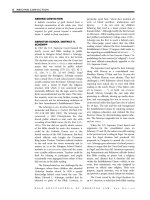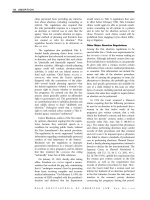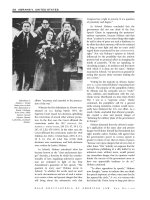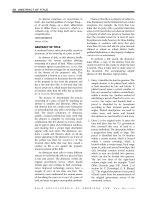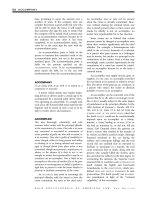Gale Encyclopedia Of American Law 3Rd Edition Volume 1 P37 doc
Bạn đang xem bản rút gọn của tài liệu. Xem và tải ngay bản đầy đủ của tài liệu tại đây (351.63 KB, 10 trang )
agreement required him to pay substantial
arbitration costs. In reviewing his claim and the
agreement at issue, the Alaska court agreed with
the employee, finding that arbitration may be
required only if the employer agrees to pay the
arbitration costs. Despite this decision, the trend
still favors arbitration of disputes over litigation
of such disputes within the court system.
FURTHER READINGS
Carbonneau, Thomas E. 2009. Arbitration in a Nutshell. 2d
Ed. St. Paul, Minn.: West.
Coltri, Laurie S. 2010. Alternative Dispute Resolution: A
Conflict Diagnosis Approach. Boston: Prentice Hall.
Crowley, Thomas. 1994. “The Art of Arbitration Advocacy.”
Hawaii Bar Journal (September).
Culiner, Helen. 1994. “Practical Guidelines for Lawyers
Representing Clients in Arbitration Proceedings To-
day.” Dispute Resolution Journal (September).
Deye, James, and Lesly Britton. 1994. “Arbitration by the
American Arbitration Association.” North Dakota Law
Review.
Nolan-Haley, Jacqueline M. 2008. Alternative Dispute
Resolution in a Nutshell. 3d ed. St. Paul: West Wads-
worth.
Silverman, Peter 2009. “A Client’s Guide to Mediation and
Arbitration.” American Bar Association (February).
Ware, Stephen J. 2001. Alternative Dispute Resolution. St.
Paul: West Wadsworth.
CROSS REFERENCE
Alternative Dispute Resolution.
ARCHITECT
A person who prepares the plan and design of a
building or other structure and sometimes super-
vises its construction.
A landscape architect is responsible for the
arrangement of scenery over a tract of land for
natural or aesthetic purposes in order to
enhance or preserve the property.
Regulation
The practice of planning and designing a
building requires the application of specialized
skill and knowledge. Because the product of an
architect’s work is used by members of the
general public, the legislature of a state may
regulate the practice of those engaged in the
profession. Regulatory statutes designed to
protect public health and safety are created
under the inherent authority of a state to
protect the welfare of its citizens. As a general
rule, regulatory statutes are valid, provided they
are not unreasonable.
Statutes requiring that architec ts must be
registered and licensed are based on
PUBLIC
POLICY
aimed at protecting citizens from un-
qualified practitioners. In many states, statutes
call for the revocation of a license for such
conduct as fraud, dishonesty, recklessness,
incompetence, or
MISREPRESENTATION when an
architect acts in his or her professional capacity.
The power to revoke a license is commonly
given by the legislature to a state board of
architects who must act in a manner prescribed
by statute. Generally, an architect is entitled to
notice and a hearing when the board seeks to
revoke his or her license. The architect can
appeal a revocation.
Qualifications
Statutes setting forth the requirements for
obtaining a license or registration generally
require that the applicants be of
LEGAL AGE and
of good moral character, have completed a
certain course of study, and have a certain
amount of practical experience. Many states have
an additional requirement that applicants must
pass an examination. A legislature may provi de
that certain persons who have practiced architec-
ture for a period of time prior to legislation
requiring an examination may register as archi-
tects without an examination. Such a statutory
provision is called a
GRANDFATHER CLAUSE.
Persons who present themselves to the
public as architects must comply with the
statutory registration and licensing require-
ments. The failure to do so is unlawful. In
most states, persons who falsely hold themselves
out as licensed architects are guilty of a
misdemeanor, and contracts rendered by them
with others are void and unenforceable.
Employment
The terms and conditions of an architect’s
employment are designated in a contract and
are governed by general rules of contract law.
Ordinarily, the person who employs the archi-
tect becomes the owner of the plans, unless the
employment contract states otherwise. Custom-
arily, the architect retains the plans after they
have been paid for and the builder may possess
and use them while constructing the building.
Authority and Powers
The power and authority of architects are
determined by general rules of agency law. In
most cases, unless the employment contract
states otherwise, architects are held to be agents
with limited authority. An employer is liable for
GALE ENCYCLOPEDIA OF AMERICAN LAW, 3RD E DITION
348 ARCHITECT
acts of an architect when they are within
the scope of the architect’s agency, although
the contracting parties may further restrict the
powers if they so desire.
Architects have a duty to exercise their
personal skill and judgment in the performance
of their work, and they may not delegate this duty
without express authority to do so. They may,
however, delegate responsibility to subordinates
while performing their duties as agents.
A supervising architect does not have
implied authority to perform work that has
been assigned to a contractor or to employ or
discharge workers. The supervising architect
does, however, have authority to make decisions
concerning proper workmanship, fitness of
materials, and the manner of work.
Duties and Liabilities
Although the duties of architects generally
depend on what is designated in the employ-
ment contract, some duties are carried out as a
matter of custom, such as the duty to supervise
construction.
Architects are in a fiduciary relationship
with their employers, and as such they must
exercise
GOOD FAITH and loyalty toward them. As
professionals, they are held to a standard of
reasonable and ordinary care and skill in
applying their knowledge and must conform
to accepted architectural practices. The failure
to exercise reasonable care and skill can result in
liability for damages and the loss of the right to
recover compensation for their services.
Compensation
Architects have a right to compensation for
their services unless there is an agreement that
they shall work gratuitously. To be entitled to
compensation, they must carry out their
contract with reasonable skill and care and
without any substantial omissions or imperfec-
tions in performance. The employment contract
usually fixes the amount of compensation. A
standard payment scale created by the American
Institute of Architects is customarily used to
determine the amount of compensation.
In the event that an architect is refused
payment for services, he or she may sue for the
amount of compensation agreed upon in the
employment contract or, in the absence of an
agreement, for the reasonable value of the
services under the theory of
QUANTUM MERUIT.
ARCHITECT OF THE CAPITOL
Established as a permanent office in 1876 (40
U.S.C.A. §§ 162, 163), the architect of the capitol
oversees the mechanical and structural mainte-
nance of the Capitol, the conservation and care of
works of art in the building, the upkeep and
improvement of the Capitol grounds, and the
arrangement of inaugural and other ceremonies
held in the building or on the grounds. In
addition, the architect is responsible for the
upkeep of all the congressional offi ce buildings,
the
LIBRARY OF CONGRESS buildings, the U.S.
Supreme Court building, the Federal Judiciary
Building, the Capitol Power Plant, the Capitol
Police headquarters, and the Robert A. Taft
Memorial. The architect also serves as the acting
director of the U.S. Botanic Garden.
The functions of the architect have become
increasingly administrative, and the architectur-
al or engineering dimensions less important.
Special projects carried out by the architect
include building renovation and restoration,
including installation of broadcasting and
security equipment in the Capitol.
Before 1989 the position of architect of the
capitol was filled for an indefinite term by
presidential appointment. Legislation enacted in
1989 (Pub. L. No. 101-163, 103 Stat. 1068
[codified at 40 U.S.C.A. § 162–1]) provided that
the architect be appointed for a ten-year term
by the president, with the
ADVICE AND CONSENT of
the Senate, from a list of three candidates
recommended by a congressional commission.
Upon confirmation by the Senate, the architect
becomes an official of the legislative branch as
an officer and agent of Congress and is eligible
for reappointment after completion of a term.
FURTHER READINGS
Aikman, Lonnelle M.1991.We, the People: The Story of the
United States Capitol, Its Past and Its Promise.
Washington, D.C.: U.S. Capitol Historical Society.
The Architect of the Capitol Web site. Available online at
(accessed August 28, 2009).
U.S. Government Printing Office Web site. Available online
at website home
page: (accessed July 4,
2009).
ARCHITECTURAL BARRIERS ACT
OF 1968
See DISABILITY DISCRIMINATION.
GALE ENCYCLOPEDIA OF AMERICAN LAW, 3RD E DITION
ARCHITECTURAL BARRIERS ACT OF 1968 349
ARCTIC, LEGAL STATUS OF
Establishment of territorial SOVEREIGNTY over
portions of the Arctic and its seabed has become
increasingly attractive to many nations for
military purposes or as a source of minerals.
Under
INTERNATIONAL LAW, national claims of
sovereignty over the Arctic traditionally were
recognized only if accompanied by physical
occupation. Consequently, two competing theo-
ries developed: (1) that no nation could achieve
sovereignty over the Arctic (res nullius), and (2)
that every nation shared in undivided sovereignty
over the area (res communes). According to
international law, sovereignty is considered to
be a derivative of the exercise of government
functions and of notoriety over new territory.
Therefore, national claims of sovereignty over
portions of the Arctic that are supported by such
governmental activity have become more plausi-
ble. Many such claims have rested on the sector
principle, a version of the doctrine of contiguity,
to define the area included in the claim. The
sector principle traces longitudinal parallels from
borders of countries adjacent to the Arctic Circle
to the North Pole, assigning the sectors so
formed to the neighboring nations. Claims
resting solely on the sector principle have been
denied legal force by many nations, including the
United States, and it appears that only those
claims of sovereignty accompanied by govern-
ment control may be eventually accepted under
international law.
CROSS REFERENCES
Boundaries; Territory.
ARGUENDO
In the course of the argument.
When the phrase in arguendo is used by a
judge during the course of a trial, it indicates
that his or her comment is made as a matter of
argument or illustration only. The statement
does not bear directly upon the remainder of
the discussion.
ARGUMENT
A form of expression consisting of a coherent set of
reasons presenting or supporting a point of view; a
series of reasons given for or against a matter
under discussion that is intended to convince or
persuade the listener.
For example, an argument by counsel
consists of a presentation of the facts or evidence
and the inferences that may be drawn therefrom,
which are aimed at persuading a judge or jury to
render a
VERDICT in favor of the attorney’s client.
An attorney may begin to develop an
argument in the
OPENING STATEMENT, the initial
discussion of the case in which the facts and the
pertinent law are stated. In most cases, however,
an attorney sets forth the main points of an
argument in the
CLOSING ARGUMENT, which is the
attorney’s final opportunity to comment on the
case before a judge or jury retires to begin
deliberation on a verdict.
ARGUMENTATIVE
Controversial; subject to argument.
PLEADING, in which a point relied upon is not
set out, but merely implied, is often labeled
argumentative. Pleading that contains argu-
ments that should be saved for trial, in addition
to allegations establishing a
CAUSE OF ACTION or
defense, is also called argumentative.
v
ARISTOTLE
Aristotle was born in 384 B.C., in Stagira, Greece.
He achieved prominence as an eminent philos-
opher who greatly influenced the basic princi-
ples of philosophy and whose ideologies are still
practiced in the early 2000.
Aristotle 384–322 B.C.
❖
❖
◆
◆
◆
428 Birth
of Plato
384 Born,
Stagira, Greece
◆
368–348 Studied
under Plato at the
Academy
343–340 Tutor
to young
Alexander
336 Reign of
Alexander the
Great, King of
Macedonia, began
348 Death
of Plato
322 Died, Chalcis, Greece
323 Alexander
the Great died
335 Established Peripatetic
(school) in the Lyceum
▼▼
▼▼
450 B.C.450 B.C.
400400
375375
350350
325325
B.C. 300B.C. 300
425425
◆
GALE ENCYCLOPEDIA OF AMERICAN LAW, 3RD E DITION
350 ARCTIC, LEGAL STATUS OF
Aristotle was a student of the renowned
philosopher Plato and tutored Alexander the
Great, who became King of Macedonia in 336
B.C.
Aristotle established his own school in the
Lyceum, near Athens, in 335
B.C. He often
lectured his students in the portico, or walking
place, of the Lyceum. The school was subse-
quently called Peripatetic, after the Greek word
peripatos for “walking place.”
In 323
B.C. the reign of Alexander ended
with his death, and Aristotle sought refu ge at
Chalcis.
Aristotle formulated numerous beliefs about
the reasoning power of humans and the essence
of being. He stressed the importance of nature
and instructed his pupils to closely study natural
phenomena. When teaching science, he believed
that all ideas must be supported by explanations
based upon facts.
Concerning the realm of politics, Aristotle
propounded that humans are inherently politi-
cal and demonstrate an essential part of their
humanity when participating in civic affairs.
Philosophy was a subject of great interest to
Aristotle, and he theorized that philosophy was
the foundation of the ability to understand the
basic axioms that comprise knowledge. In order
to study and question completely, Aristotle
viewed logic as the basic means of reasoning. To
think logically, one had to apply the syllogism,
which was a form of thought comprised of two
premises that led to a conclusion; Aristotle
taught that this form can be applied to all logical
reasoning.
To understand reality, Aristotle theorized that
it must be categorized as substance, quality,
quantity, relation, determination in time and
space, action, passion or passivity, position, and
condition. To know and understand the reality of
an object required an explanation of its material
cause, which is why it exists or its composition; its
formal cause, or its design; its
EFFICIENT CAUSE,orits
creator; and its final cause, or its reason for being.
Aristotle agreed with his mentor, Plato,
concerning the field of ethics. The goodness of a
being depended upon the extent to which that
being achieved its highest potential. For
humans, the ultimate good is the continual
use and development of their reasoning powers
to fullest capacity. To effect fulfillment and
contentment, humans must follow a life of
contemplation, rather than pleasure.
The fundamental source of Aristotle’s theo-
ries were his lectures to his students, which were
compiled into several volumes. They include
Organum, which discusses logic; Physics; Meta-
physics; De Anima, concerning the soul; Rheto-
ric; Politics; Nichomachean Ethics and Eudemian
Ethics, involving principles of conduct; and De
Poetica, or poetics.
He also wrote Constitution of Athens, a
description of the foundations of the govern-
ment of Athens. The work was discovered in the
late nineteenth century.
Aristotle died in 322
B.C., in Chalcis, Greece.
ARMED SERVICES
The Constitution authorizes Congress to raise,
support, and regulate armed services for the
national defense. The
PRESIDENT OF THE UNITED
STATES
is commander in chief of all the branches
of the services and has ultimate control over
most military matters.
The United States has always been wary of
maintaining a strong military force. This
concern was shown by the Framers of the
Constitution when they finally allowed the
creation of a standing army but at the same
time limited the process by which money could
Aristotle.
LIBRARY OF CONGRESS
MAN IS BY NATURE A
POLITICAL ANIMAL
.
—ARISTOTLE
GALE ENCYCLOPEDIA OF AMERICAN LAW, 3RD E DITION
ARMED SERVICES 351
be raised to support the military; they required
that Congress review the appropriations every
two years. In this way, the Framers ensured that
members of each new Congress had the
opportunity to address their lingering concerns
about domestic tyranny with a fresh perspective.
Furthermore, the Framers ensured that the
states could maintain their own militias and
protect themselves from federal military domi-
nation, by recognizing “the right of the people
to keep and bear Arms” (U.S. Const. amend. 2).
The various branches of the armed services
were created at different times to serve different
purposes. The earliest branch was the Army,
instituted on July 14, 1775, followed closely by
the Navy and the Marine Corps in the same year.
All three were established to respond to the
needs of the revolutionary forces fighting the
British. The Navy and the Marine Corps were
disbanded after the Revolutionary War but were
reestablished in 1798. The Coast Guard traces its
origins to 1790 but was officially created in 1915.
Finally, the Air Force had its genesis in the Signal
Corps of the Army and was formally established
as the Army Air Service in 1920.
Military personnel are governed by a set of
laws that is separate from and independent of
CIVIL LAW. The UNIFORM CODE OF MILITARY JUSTICE
(10 U.S.C.A. § 801 et seq.) outlines the basic
laws and procedures governing members of the
armed services.
MILITARY LAW is mainly con-
cerned with maintaining order and disc ipline
within the ranks. It is unrelated to
MARTIAL LAW,
which is the temporary imposition of military
rule during a national or regional crisis. Off-
enses committed by members of the armed
services are tried by a
COURT-MARTIAL, a special
tribunal created specifically to hear a military
case and then disband ed once judgment and
punishment are pronounced.
The constitutionality of the military legal
system has been challenged several times
without success. In 1994 the Supreme Court
reaffirmed the constitutionality of the system
with a unanimous decision in Weiss v. United
States, 510 U.S. 163, 114 S. Ct. 752, 127 L. Ed.
2d 1. At issue were the selection process and
tenure of military judges, who are chosen by
their branch’s
JUDGE ADVOCATE general. The
plaintiffs claimed that because the judges could
be removed at any time by the judge advocate
general, they were biased toward the prosecution
and could not be impartial. The Court held that
sufficient safeguards were in place to protect
against improper influence by the judge advocate
general and that the defendants’
FIFTH AMENDMENT
due process rights had not been violated.
Major Events Affecting
Armed Services
End of the Cold War With the breakup of the
Soviet Union and the end of the
COLD WAR,the
U.S. government began the politically charged
task of reducing military budgets and closing
or -shrinking unnecessary military installations.
The Defense Base Closure and Realignment
Act (10 U.S.C.A. § 2687), passed by Congress in
1990, set off a firestorm of controversy over
which bases should be closed and whether the
country’s military readiness was being compro-
mised. The act created a presidential commis-
sion to decide which bases to close based on
Pentagon recommendations. The commission’s
decisions are sent to the president, who accepts
or rejects them in their entirety. If accepted, the
recommendations are sent to Congress, which
can only block the closings if both houses pass
a resolution of disapproval within 45 days.
Commissions meeting in 1988 , 1991, and 1993
decided to close a total of 70 major installatio ns.
The base closures came under immediate
fire as senators and representatives tried to
ILLUSTRATION BY GGS
CREATIVE RESOURCES.
REPRODUCED BY
PERMISSION OF GALE,
A PART OF CENGAGE
LEARNING.
Military Personnel on Active Duty,
1970 to 2007
Number of personnel, in millions
1970 1980 1990 2000 2007
4.0
3.5
3.0
2.5
2.0
1.5
1.0
0.5
0.0
SOURCE: U.S. Department of Defense, DefenseLINK
and Personnel and Procurement Statistics.
3.065
2.051
2.046
1.384
1.380
Year
GALE ENCYCLOPEDIA OF AMERICAN LAW, 3RD E DITION
352 ARMED SERVICES
prevent bases in their home states or districts
from being shut down. One group of elected
officials, including the four senators from
Pennsylvania and New Jersey, brought suit in
federal court to challenge the procedures under
the Defense Base Closure and Realignment Act
and to block the closing of the Philadelphia
Naval Shipyard, one of the region’s biggest
employers. The case never went to trial. Instead,
the U. S. Supreme Court agreed to hear the
Clinton administration’s appeal on the question
of whether the suit could be brought at all. The
Court held that the government’s choice of
which bases to close under the act could not be
challenged in federal court (Dalton v. Specter,
511 U.S. 462, 114 S. Ct. 1719, 128 L. Ed. 2d 497
[1994]).
At about the same time the Dalton decision
was announced, the
DEFENSE DEPARTMENT,con-
cerned about the effect of base closings on
surrounding communities, began planning to
postpone the final round of shutdowns sched-
uled to follow the commission’s 1995 meeting.
A senior Pentagon official defended the delays,
saying, “As the defense budget goes down and
we close bases, the issue now is the pace of
closures so people and communities can adjust.”
Some critics claimed that the delays were a
political move designed to take pressure off
the president and Congress until after the 1996
election.
The issue of cost and the shrinking military
budget loomed large in the debate. The purpose
of closing the bases was to eliminate unneces-
sary costs, but the process of preparing a base
for nonmilitary use was itself expensive. Mili-
tary bases are exempt from federal environmen-
tal regulations, but when they are converted to
private use, all the stockp iled weaponry and
toxic waste must be disposed of in order to
avoid liability. The government had set aside $3
billion per year to cover environmental cleanup
plus construction and repair of buildings and
roads. Still, the projected savings by the end of
the 1990s was $4.6 billion per year.
Foreign Policy after September 11 Terrorist
Attacks The
SEPTEMBER 11TH ATTACKS perpetrat-
ed on the United States in 2001 required the
country to reevaluate its military policies.
President
GEORGE W. BUSH announced immedi-
ately that the U.S. would wage an unprecedent-
ed
WAR ON TERRORISM and focused his attention
initially on the Taliban regime of Afghanistan
for allegedly harboring Osama bin Laden, who
led the terrorist organization al Qaida. Within
months, the military began an aggressive
operation in Afghanistan, which led quickly to
the dismantling of the Taliban regime.
Following the fall of the Taliban, the United
States quickly turned its attention to Iraq. On
March 19, 2003, Operation Iraqi Freedom
began, leading to the collapse of the regime of
Saddam Hussein only weeks later. The United
States captured Baghdad on April 9, 2003.
Despite the early success, the
IRAQ WAR contin-
ued for the remainder of the decade. The
United States maintained a presence in Iraq,
keeping between 100,000 and 200,000 troops in
the country from 2003 through 2009. During
that time, an estimated 4,296 U.S. troops were
killed, while 31,102 were wounded.
Military operations against terrorist groups
differ from those against foreign nations
because the terrorist groups are, by their nature,
mobile “armies.” The United States has focused
much of its attention on the use of military
intelligence, as well as intelligence from such
civil agencies as the
CENTRAL INTELLIGENCE AGENCY.
Accordingly, much of the deployment of mili-
tary personnel in this war was covert in specific
regions.
Military spending steadily increased under
the Bush administration. In 2001 total military
spending was $307.8 billion. By 2006 this
number had increased to $535.9 billio n, not
including expenditures authorized specifically
for the Iraq War. Although spending increased
during the 2000s, military personnel numbers
remained steady. As of December 31, 2002, the
Members of the
Army, one of the
branches of the armed
services, train for
urban warfare before
the invasion of Iraq in
March 2003.
AP IMAGES
GALE ENCYCLOPEDIA OF AMERICAN LAW, 3
RD E DITION
ARMED SERVICES 353
military had a total of 1.411 million personnel.
As of December 31, 2008, the number of
personnel was 1.402 million.
Legal and Political Issues
Military Ban on Gay and Lesbian Behavior One
controversial and divisive issue facing the
military is the inclusion of gay and lesbian
personnel. For more than 50 years, the U.S.
armedservicesprohibitedgaymenandlesbians
from serving in the military. In the past,
members who disclosed that they were gay or
lesbian were subject to immediate discharge.
That policy was challenged in several prominent
The Branches of the Armed Services
T
B
he five branches of the U.S. armed services are
staffed by volunteer enlisted men and women
who hold various ranks. Military personnel are no
longer conscripted, or drafted, into service.
Army
The Army was the first branch of the armed services
established by Congress. The U.S. Army evolved
from the Continental Army, created on July 14, 1775,
by the Continental Congress to fight the Revolution-
ary War against the British.
The three segments of the Army are the Army
Reserve, the Army National Guard , and the Active
Army. The Army Reserve provides training and
combat support t o the Active Army in times of
emergency. The Army National Guard, the oldest
military forc e in the United States, began in the
Massachusetts Bay Colony in 1636. During peace-
time, the National Guard unit in each state is
commanded by the state governor. The National
Guard often assists in natural disasters, such as
earthquakes or floods, or in civil unrest, such as
riots. The president has the authority to call the
Guard to federal duty when necessary. For example,
President Dwight D. Eisenhower fede ralized the
Arkansas National Guard in 1957 and assigned them
to control angry mobs protesting the enro llment
of African American students in a previously
segregated Little Rock high school. Simi larl y,
President George H.W. Bush assigned Guard units
to duty with the Active Army during the Persian Gulf
War of 1991.
The Army’s many responsibilities include com-
bat, combat support, and combat service support
arms. The comb at arms, including the infantry,
armored divisions, air defense artillery, field artil-
lery, and aviation, are directly i nvolved in fighting.
The combat support arms include the Corps of
Engineers, the Signal Corps, the Military Police
Corps, the Chemical Corps, and military intelligence.
The combat s ervice support arms provide logistical
and administrative assistance to the other arms.
Women were originally restricted to the Women’s
Army Corps (WAC) but now serve alongside men in
almost all capacities. Their roles have been gradually
expanded, and they now serve in combat units, which
gives them equal opportunities with men for higher
pay and advancement in rank.
The U.S. Military Academy, the oldest of the
service academies, was established at West Point,
New York, in 1802. It was originally charged with
training army engineers, but evolved into the
training ground for those wishing to become
officers in the Army. West Point has been
coeducational since 1976.
Navy
The Navy traces its origins to 1775 and the
American Revolution. A fleet established to fight
the Bri tish was disbanded after the war, b ut the
need for a naval force was again recognized in
1798, when Congress established the N avy Depart-
ment. The Navy was a separate branch of the
government until the National Security Act of 1947
(5 U.S.C.A. § 101 et seq., 10 U.S.C.A. § 101 et seq., 50
U.S.C.A. § 401 et seq.) created the Department of
Defense with a cabinet-level secretary to oversee
all branches of the mi litary.
The Navy’s forces are grouped into various
fleets that se rve in different areas of the world.
Traditionally, odd-numbered fleets, such as the
Third and Seventh Fleets, have served in the Pacifi c
Ocean. Even-numbered fleets, such as the Second
and Sixth Fleets, have served in the Atlantic Ocean.
Over the years, U.S. Navy fleets have been
disestablished (removed from service) and recon-
stituted (restored to servi ce) as the distri bution of
military power throughout the world has changed.
GALE ENCYCLOPEDIA OF AMERICAN LAW, 3RD E DITION
354 ARMED SERVICES
cases during the late 1980s and early 1990s, and
the Clinton administration addressed the issue
with a new approach that ultimately led to more
confusion and controversy.
The federal courts tackled the question of
whether the military’s automatic ouster of gay or
lesbian personnel is constitutional, in Meinhold v.
United States DEPARTMENT OF DEFENSE, 34 F.3d 1469
(9th Cir. 1994). The
PLAINTIFF, Petty Officer Keith
Meinhold of the Navy, annou nced on a national
television broadcast in May 1992 that he is gay.
As a result, discharge proceedings were begun
against him. Meinhold was dismissed solely on
the basis of his televised statement. He sued the
A naval reserve force is made up of civilians
who t rain regularly and stand ready to be called in
times of need.
Although women originally could only join the
Women Accepted for Voluntary Emergency Service
(WAVES), they now serve alongside men, drawing
equal pay and attaining equivalent rank.
The Nava l Academy, at Annapolis, Maryland,
wasestablishedin1845totrainyoungmentobe
officers in the Navy and the Marine Corps. Women
have been admitted since 1976.
Air Force
The Aeronautical Division of the Army Signal Corps,
the precursor to the U.S. Air Force, was established
on Au gust 1, 1907. The First Aero Squadron was
organized in 1914 and served with the Mexican
Border Expedition in 1916. The Air Force remained a
division of the Army until 1947.
The Air Force is responsible for domestic
security in such areas as the Strategic Air
Command (SAC), which plays a major role in
deterring air and missile attacks as well as
conducting space surveillance. Other responsibili-
ties of the Air Force include maintaining a combat-
ready mobile strike force and operating air bases in
key areas around the world.
The Air Force’s chief of staff, along with the
chiefs of staff of the Army and the Navy, is a
member of the Joint Chiefs of Staff, which advises
the president and the secretary of defense.
The Air Force Academy, authorized in 1954 and
located in Colorado Springs, Colorado, prepares
college students to become officers in the Air Force.
Womenwereadmittedbeginningin1976.
Marine Corps
Steeped in history, tradition, and folklore, the
Marine Corps, a self-contained amphibious comb at
force within the Department of the Navy, trace s its
roots to the Revolutionary War. During its two
hundred-year history, the U.S. Marines has fulfilled
its obligation to provide air, land, and sea support
for naval forces, establish beachheads during war,
and protect U.S. lives and interests at foreign
embassies an d legations.
The Marines maintai n a large reserve unit,
which, when mobilized in times of crisis, can
increase the corps strength by 25 percent within
weeks.
The Marine Corps Women ’s Reserve, estab-
lished in 1942, provides support in the mainland
United States and in Hawaii so that men are
available for combat.
Marine Corps officers are traine d mainly at the
U.S. Naval Academy, at Annapolis.
Coast Guard
The U.S. Coast Guard was first e stablished in 1790
as the U.S. Lighthouse Service under the Depart-
ment of the Treasury. It later moved to the
Department of Transportatio n, where it remained
for 36 years. On February 25, 2003, the Coast Guard
officially transferred to the Department of Homeland
Security, where it comprises about one-fourth of the
new department. The move was part of the largest
government reorganization since the Defense De-
partment was established in 1947.
The Coast Guard is charged with guarding the
country’s coasts against smuggling, enforcing
customs laws, and responding to emergencies
along the coasts. The move to the Department of
Homeland Security did not change the Coast
Guard’s m ission significantly, although it is now
responsible for securing the nation’s ports and has
been prepared to be involved with international
conflicts in the war on terrorism.
The Coast Guard provides officer training for
college students at the Coast Guard Academy, at
New London, Connecticut, which began a dmitting
women in 1976.
CROSS REFERENCES
Homeland Security Department; Military Law.
B
GALE ENCYCLOPEDIA OF AMERICAN LAW, 3RD E DITION
ARMED SERVICES 355
Navy and the Department of Defense, claiming
that their policy was unconstitutional. The
district court agreed, holding that the Navy’s
actions denied gay men and lesbians
EQUAL
PROTECTION
under the law. In August 1994 the
Court of Appeals for the Ninth Circuit agreed
that Meinhold could not be discharged merely
for stating that he was gay. However, the appeals
court disagreed with the district court’s finding
that the military’s policy was unconstitutional
and instead found that by discharging Meinhold
because of his status as gay and not because of any
actions on his part, the Navy was equating status
with prohibited conduct. The court conceded
that the Navy could legally discharge someone
who manifested a “fixed or expressed desire to
commit a prohibited act,” such as engaging
in gay sex but found that Meinhold had not
manifested any such desire and, therefore, must
be reinstated. In November 1994 the Clinton
administration announced it was dropping its
efforts to bar Meinhold from serving and would
not appeal the Ninth Circuit’s ruling.
Another challenge to the military ban on
gays and lesbians occurred in Steffan v. Aspin, 8
F.3d 57 (D.C. Cir. 1993). The plaintiff, Joseph
Steffan, admitted to being gay just six weeks
before his expected graduation from the U.S.
Naval Academy, at Annapolis, Maryland, in
1987. Steffan was one of the top ten students in
his class. He had consistently received outstand-
ing marks for leadership and military perfor-
mance. In his junior year he was named a
battalion commander in charge of one-sixth of
the academy’s 4,500 students. After Steffan
acknowledged his homosexuality to a classmate
and a chaplain, he was brought before a dis-
ciplinary board that recommended he be dis-
charged. Rather than face dismissal, he resigned.
Sometime later, he asked to be reinstated. His
request was denied, and he then sued for
reinstatement to his commission, claiming that
he was forced to resign because of his status as
a gay, not because of any conduct—in violation
of the Constitution’s equal protection guarantee.
The district court granted
SUMMARY JUDGMENT
for the government (Steffan v. Cheney, 780 F.
Supp. 1 [D.D.C. 1991]). A three-judge panel for
the court of appeals reversed, stating that the
dismissal policy had no rational basis and that it
violated the Equal Protection Clause of the Fifth
Amendment. The appeals court ordered the
academy to award Steffan his diploma and
reinstate him to his commission.
The government petitioned the court for a
rehearing on whether the three-judge panel had
exceeded its authority. The full court of appeals
vacated the decision of the panel and ordered a
rehearing before the full court on the constitu-
tionality question. In November 1994, the full
court reversed the decision of the three-judge
panel and held that Steffan’s dismissal did not
violate the Constitution. The court said that the
Navy’s ban on homosexuals, like its height or
eyesight requirements, did have a rational basis.
The court also dismissed Steffan’s argument
that the ban punished status rather than
conduct. Judge Laurence H. Silberman, writing
for the majority, said, “Steffan’s claim that the
Government cannot rationally infer that one
who states he or she is gay or lesbian is a
practicing homosexual, or is at least likely to
engage in homosexual acts, is so strained a
constitutional argument as to amount to a basic
attack on the policy itself” (Steffan v. Perry, 41
F.3d 677, 693 [D.C. Cir. 1994]). In an impas-
sioned dissent, Judge
PATRICIA M. WALD wrote, “In
years to come, we will look back with dismay
at these uncon stitutional attempts to enforce
silence upon individuals of homosexual orien-
tation, in the military and out. Pragmatism
should not be allowed to trump principle, or the
soul of a nation will wither” (41 F.3d 677, 721).
In January 1995 Steffan announced that for
tactical reasons he would not appeal the decision
to the Supreme Court. Steffan’s case was brought
under the old policy, and he and his attorneys
felt that the best case to have the Supreme Court
address was one involving the new policy, which
they believed was more vulnerable to constitu-
tional attack. After his discharge from the naval
academy, Steffan became a lawyer.
The case of Colonel Margarethe Cammer-
meyer further clouded official policy on homo-
sexuals in the military (Cammermeyer v. Aspin,
850 F. Supp. 910 [W.D. Wash. 1994]). Cam-
mermeyer was dismissed from the Washington
State
NATIONAL GUARD in June 1992 when she
acknowledged in a security-clearance interview
that she is a lesbian. Under the rules in effect
at the time, her statement was grounds for
dismissal, and Cammermeyer was given an
honorable discharge. She was the highest-
ranking officer to be discharged solely because
of gay or lesbian orientation.
Cammermeyer, a highly respected nurse
who was awarded the Bronze Star for her service
with the Army in Vietnam, appealed the
GALE ENCYCLOPEDIA OF AMERICAN LAW, 3RD E DITION
356 ARMED SERVICES
dismissal. In June 1994 Judge Thomas Zilly, of
the Federal District Court for the District of
Washington, ordered the military to reinstate
Cammermeyer, holding that the policy in effect
at the time of her dismissal violated the Equal
Protection Clause. Zilly’s decision dismantled
the assumptions that formed the basis for both
the old and the new government policies
regarding gays and lesbians in the military. Zilly
held that “there is no rational basis for the
Government’s underlying contention that gay
or lesbian orientation equals desire or propen-
sity to engage” in gay or lesbian conduct (850 F.
Supp. at 920). The judge was direct and harsh in
his criticism of the government’s policy. He
wrote, “The Government has discriminated
against Colonel Cammermeyer solely on the
basis of her status as a lesbian and has failed to
demonstrate a rational basis for doing so” (850
F. Supp. at 926). Noting that military experts
“conceded that their justifications for the policy
are based on heterosexual members’ fear and
dislike of homosexuals,” Zilly went on to say,
“[m]ere negative attitudes, or fear, are constitu-
tionally impermissible bases for discriminatory
governmental policies” (850 F. Supp at 925).
The
JUSTICE DEPARTMENT moved to delay
Cammermeyer’s reinstatement, but the U.S. Court
of Appeals for the Ninth Circuit refused the
request. Cammermeyer returned to her position
as chief of nursing services for the 164th Mobile
Army Surgical Hospital in July 1994.
At the same time that Meinhold, Steffan, and
Cammermeyer were being decided, the Clinton
administration was formulating and imple-
menting a new policy that it hoped would deal
with the issue of gays and lesbians in the
military and put the controversies surrounding
the old policy to rest. Before he was elected,
BILL
CLINTON
had promised that as president, he
would lift the ban on gay men and lesbians in
the armed services. However, after taking office,
Clinton faced strenuous opposition from the
Joint Chiefs of Staff and the heads of the service
branches, who argued that summarily eliminat-
ing the ban on gays and lesbians would lead to
dissension among the troops and diminished
military readiness. In December 1993 the
Pentagon announced a compromise plan, which
came to be known as the “don’t ask, don’t tell,
don’t pursue” policy (Policy Concerning
Homosexuality in the Armed Forces, Pub. L.
No. 103-160, 1993 H. R. 2401 § 571(a)
[amending 10 U.S. C.A. § 654]). Under the
new rules, gay men and lesbians could serve in
the military as long as they kept their sexual
orientation private and did not engage in gay or
lesbian activity. The policy stated that sexual
orientation is a “personal and private matter”
about which recruits and members of the armed
forces would no longer be required to answer
questions. Criminal investigations and security
checks conducted solely to determine sexual
orientation would be eliminated. Sexual orienta-
tion alone would not be a bar to service. However,
gay or lesbian conduct, which could take the
form of “a homosexual act, a statement by the
member that demonstrates a propensity or intent
to engage in homosexual acts, or a homosexual
MARRIAGE or attempted marriage” would subject
the individual to dismissal. An acknowledge-
ment of gay or lesbian orientation would not be
sufficient grounds for expulsion but could be
the basis for an investigation into whether the
individual engaged in gay or lesbian acts.
Gay rights advocates immediately and
vigorously criticized the new policy, saying it
infringed on the free speech rights of gay service
members and vowed to challenge it in court. In
the months following implementation of the
new rules, it became clear that, far from easing
the plight of homosexual service members,
“don’t ask, don’t tell, don’t pursue” was actually
making life worse for many of them. Some
commanding officers were overly aggressive in
Col. Margarethe
Cammermeyer was
dismissed from the
Washington State
National Guard in
1992 after
acknowledging that
she was a lesbian. She
was reinstated two
years later and in
1997 retired with full
military privileges.
AP IMAGES
GALE ENCYCLOPEDIA OF AMERICAN LAW, 3
RD E DITION
ARMED SERVICES 357



